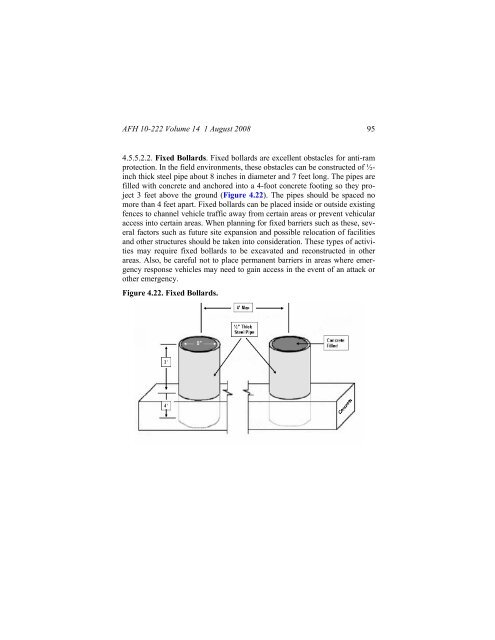Civil engineer guide to fighting positions, shelters, obstacles
Civil engineer guide to fighting positions, shelters, obstacles
Civil engineer guide to fighting positions, shelters, obstacles
Create successful ePaper yourself
Turn your PDF publications into a flip-book with our unique Google optimized e-Paper software.
AFH 10-222 Volume 14 1 August 2008 95<br />
4.5.5.2.2. Fixed Bollards. Fixed bollards are excellent <strong>obstacles</strong> for anti-ram<br />
protection. In the field environments, these <strong>obstacles</strong> can be constructed of ½inch<br />
thick steel pipe about 8 inches in diameter and 7 feet long. The pipes are<br />
filled with concrete and anchored in<strong>to</strong> a 4-foot concrete footing so they project<br />
3 feet above the ground (Figure 4.22). The pipes should be spaced no<br />
more than 4 feet apart. Fixed bollards can be placed inside or outside existing<br />
fences <strong>to</strong> channel vehicle traffic away from certain areas or prevent vehicular<br />
access in<strong>to</strong> certain areas. When planning for fixed barriers such as these, several<br />
fac<strong>to</strong>rs such as future site expansion and possible relocation of facilities<br />
and other structures should be taken in<strong>to</strong> consideration. These types of activities<br />
may require fixed bollards <strong>to</strong> be excavated and reconstructed in other<br />
areas. Also, be careful not <strong>to</strong> place permanent barriers in areas where emergency<br />
response vehicles may need <strong>to</strong> gain access in the event of an attack or<br />
other emergency.<br />
Figure 4.22. Fixed Bollards.
















